Environment & Society Reflections
Bill Dennison · 
In the revised Marine Environmental and Estuarine Science (MEES) curriculum, the Environment and Society Foundation is the only track that expressly incorporates social sciences. With my marine ecology background, I combined efforts with Michael Paolisso, an environmental anthropologist, to co-teach the Foundation course. Michael and I had a lot of help from our excellent teaching assistant, Suzi Spitzer, a variety of superb guest lecturers (Drs. Yancey Orr, Dana Fisher, Klaus Hubacek, Christina Prell, Heath Kelsey, and Katie May Laumann), helpful National Park Service staff (especially Sam Tamburro and Diane Pavek), and, mostly importantly, the 12 students (Brendan Campbell, Shannon Hood, Emily Nastase, Morgan Ross, Alex Sahi, Brian Scott, Natalie Peyronnin Snider, Jessie Todd, Alana Todd-Rodriguez, Srishti Vishwakarma, Matthew Wilfong, and Tan Zou) who actively participated in the course, bringing a rich diversity of experiences and perspectives to class each week.
We employed a variety of technologies during the course: 1) Camtasia to pre-record lectures, 2) YouTube to disseminate pre-recorded lectures, 3) Zoom for remote video connection, 4) Canvas to coordinate course materials, including lectures, and use SpeedGrader for essay feedback, 5) Blogs posted to the Integration and Application Network website. These technologies greatly enhanced course delivery and interactions between students and instructors. We also had two successful in-person classes at the MEES office at the University of Maryland College Park.
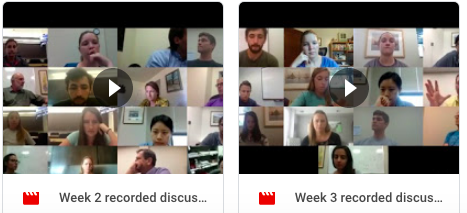
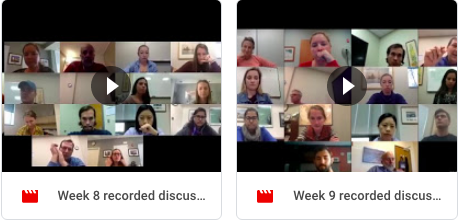
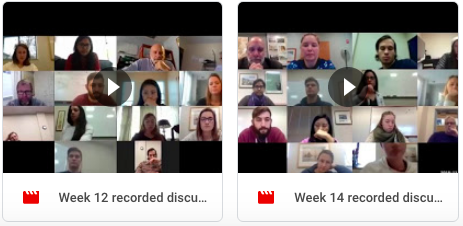
Zoom worked well for the following reasons: 1) Students and instructors could participate in class even when they were traveling. For example, I participated from Australia, Thailand, Seattle, New York, and California, albeit sometimes in the wee hours of the night. 2) The webcam of each student’s computer provided us a close up view of their faces, facilitating more intimate participation. Additionally, the student names appeared under their webcam image to help us learn their names early in the semester. 3) The students at each of the three locations where students were located gathered around conference room tables, facing one another, and creating a more interactive environment than a traditional classroom setting. 4) We had a couple of bad weather days over the course of the semester, but Zoom allowed students to participate from home instead of having to cancel class. 5) As students began to develop their projects, we were able to have breakout sessions within the class period. 6) Zoom allowed a virtual shared whiteboard where students and instructors could collaborate in real time.
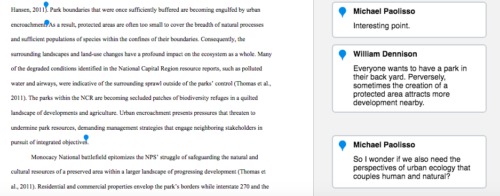
Students were assigned three to five readings prior to class and they posted essays that analyzed and discussed the readings. Instructors commented on the essays and provided grades prior to class discussion about the weekly topic. I found the essays to be incredibly valuable. It encouraged ‘active reading’ over ‘passive reading’ and allowed students to weave in their personal experiences and perspectives. The essays also served as a way to generate good discussion topics via the questions that the students posed as part of their essays.
The weekly blogs that students took turns to write and illustrate were a highlight for me. I enjoyed each of the blogs and the creative aspects that the students used to connect the topic to their lives. The blogs were a summary of the class topic, incorporating the readings and the class discussion. The course blogs can be found here.
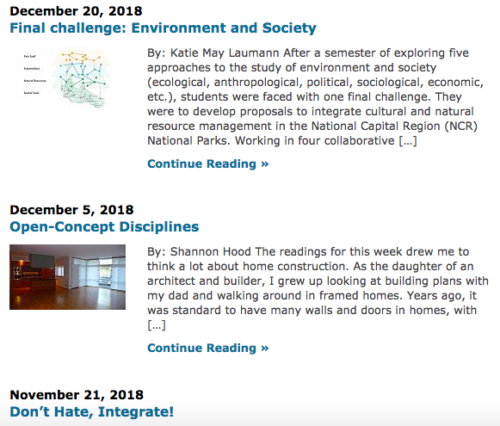
The project reports and presentations regarding the challenge of integrating both cultural and natural resources in the national parks in the Washington, DC region (National Capital Region) were also a highlight. Student groups that contained representatives from the social sciences, natural sciences, and from the different campuses were formed. Each group took a different approach, with some common themes of incorporating social network analysis, cultural consensus models, and transdisciplinary approaches.
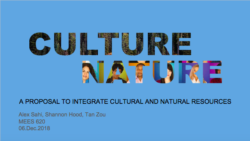
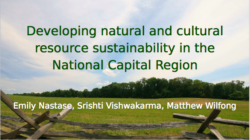

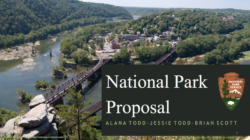
Reflecting on what I got out of this course, I think that I learned more from this course than any lecture-based course that I have either taken or taught. I consider field-based courses as the best group learning experiences, like S.E.A. Semester, so the comparison I am making is to other lecture-based courses. In Environment & Society, readings from diverse fields (e.g., natural science, anthropology, sociology, ecological economics, political science) exposed me to a diversity of academic viewpoints. Reading and grading the student essays provided a stimulating set of interpretations of the readings. The class discussions were compelling because we had all read and interpreted a common set of carefully selected readings before class time. I always anxiously awaited the blog summaries, because they were written and illustrated in a way that let me see how each student interpreted the readings and discussion. While it was a lot of work to keep up each week, the weekly deadlines kept me focused on the course. It also forced me to think more deeply about how I approach problems and how my perspective fits with perspectives from different fields. In short, Environment & Society was an amazing experience, and I am deeply grateful to you all who participated this year.
About the author
Bill Dennison

Dr. Bill Dennison is a Professor of Marine Science and Vice President for Science Application at the University of Maryland Center for Environmental Science.

